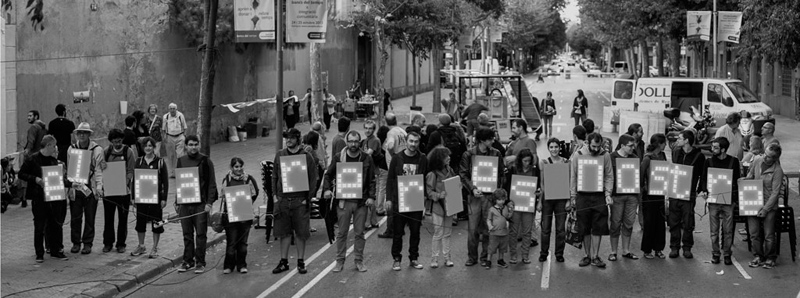Punk’s Not Dead in East LA: Exploring the East Los Series and It’s Use of Locality and Cultural Hybridity for Eastside Catharsis
DOI:
https://doi.org/10.1344/regac2015.1.08Paraules clau:
Punk, East Los Angeles, Urban Spaces, Hybridity, Cultural Identity, MarginalizationResum
Punk Rock, with its enticing ability to use rhythmic violence and hard-hitting melodies, obtained a unique niche in the backyards of East Los Angeles in the late 70's and early 80's. Punk's importance in the lives of East LA youth can be chronicled back to legendary East LA bands like Los Illegals and The Brats; yet some, like London's International Times in 1977, believed Punk was dying. Although the research that has been emerging about Punk has been insightful in understanding Los Angeles and its dichotomies, the literature seems to be stuck in the 80's, making Punk's importance in the lives of East LA youth today supposedly dead as well. Has the Punk scene in East LA truly been dead for almost thirty years? Have the youth of the Eastside found other outlets for their teenage angst, family problems, and identity crises? For these young Punkeros of Latino origins, the struggle with national identities, resistance against unemployment, and the unending combat towards advancement for minorities, are a driving force in the current Punk scene in East LA. The aim of this paper is, therefore, to analyze how Angela Boatwright’s 2014 Van’s Off The Wall documentary titled East Los used locality and bi-cultural integration in order to portray East LA “punkeros”; giving insight into the lives of Latino-American young adults in LA. Eastside youths have found a way to use Punk as a means towards catharsis, a way to not only release negative emotions, but a way to express their discontent with the status quo and their inevitable hybridity. In East LA, Punk is definitely not dead.
California Lutheran University
Referències
Alvarado, J. (2012). Backyard Brats and Eastside Punks. Aztlán: A Journal of Chicano Studies, 37(2), 157-180.
Apostasis. Personal Interview. 06 Feb 2015.
Arteaga, Dennis. Personal Interview. 31 Jan 2015.
Bag, A. (2012). Work that Hoe: Tilling the Soil of Punk Feminism. Women & Performance: a journal of feminist theory, 22(2-3), 233-238.
Boatwright, A. [Vans Off The Wall]. (2014, February 3). #LIVINGOFTHEWALL- EAST LOS [Video file]. Retrieved from https://www.youtube.com/watch?v=90XBkgcWALc
Burr, J. A., & Mutchler, J. E. (1999). Race and ethnic variation in norms of filial responsibility among older persons. Journal of Marriage and the Family, 674-687.
Duncombe, W., Robbins, M., & Wolf, D. A. (2003). Place characteristics and residential location choice among the retirement-age population. The Journals of Gerontology Series B: Psychological Sciences and Social Sciences, 58(4), S244-S252.
Ennis, S. R., Rios-Vargas, M., & Albert, N. G. (2011). The Hispanic population: 2010. 2010 census briefs. Washington, DC: US Census Bureau.
Feng, Z., Fennell, M. L., Tyler, D. A., Clark, M., & Mor, V. (2011). Growth of racial and ethnic minorities in US nursing homes driven by demographics and possible disparities in options. Health Affairs, 30(7), 1358-1365.
Gonzalez, Amanda. Personal Interview. 31 Jan 2015.
Gravedoni, Jeremy. Personal Interview. 31 Jan 2015.
Gunckel, C. (2012). "Vexing" Questions: Rethinking the History of East LA Punk. Aztlán: A Journal of Chicano Studies, 37(2), 127-156.
Johnson, G. T. (2013). Spaces of conflict, sounds of solidarity: Music, race, and spatial entitlement in Los Angeles (Vol. 36). Univ of California Press.
Leyva, D. (2004). Teenage Alcoholics: Punk Rock in East Los Angeles. Retrieved from http://www.musictap.net/DuanesPunkPitNotes/elapunk.pdf
Lipsitz, G. (1986). Cruising around the historical bloc: postmodernism and popular music in East Los Angeles. Cultural Critique, (5), 157-177.
Martín-Barbero, J. (2006). A Latin American perspective on communication/cultural mediation. Global Media and Communication, 2(3), 279-297.
McMahon, M. R. (2011). Self-Fashioning through Glamour and Punk in East Los Angeles. Aztlán: A Journal of Chicano Studies, 36(2), 21-49.
Spence, R. (2010). Poststructuralist Agency in the Southern California Punk Scene. UCLA. Center for the Study of Women.
Torres-Gil, F., & Villa, V. (1993). Health and long-term care: Family policy for Hispanic aging. Elderly Latinos: Issues and solutions for the 21st century, 45-58.
Traber, D. S. (2001). LA's" White Minority": Punk and the Contradictions of Self-Marginalization. Cultural Critique, 48(1), 30-64.
Underground Alliance. Personal Interview. 18 Feb 2015.
Viesca, V.H. (2000). Straight out the barrio: Ozomatli and the importance of place in the formation of Chicano/a popular culture in Los Angeles. Journal for Cultural Research, 4(4), 445-473.
Viesca, V.H. (2004). The battle of Los Angeles: the cultural politics of Chicana/o music in the Greater Eastside. American Quarterly, 56(3), 719- 739.
Zilberg, E. (2014). Fools banished from the kingdom: Remapping geographies of gang violence between the Americas (Los Angeles and San Salvador). American Quarterly, 56(3), 759-779.
Descàrregues
Publicades
Número
Secció
Llicència
Los autores que publican en esta revista están de acuerdo con los términos siguientes:- Los autores conservan los derechos de autoría y otorgan a la revista el derecho de primera publicación de la obra, que se difundirá con la licencia de reconocimiento de Creative Commons que permite compartir la obra con terceros, siempre que estos reconozcan su autoría, su publicación inicial en esta revista y las condiciones de la licencia.
- Los autores son libres de establecer acuerdos contractuales adicionales independientes para la distribución no exclusiva de la versión de la obra publicada en la revista (como por ejemplo su publicación en un repositorio institucional o en un libro), siempre que se reconozca su publicación inicial en esta revista.
- Se anima a los autores a publicar su obra en línea (en repositorios institucionales o en su página web, por ejemplo) antes y durante el proceso de remisión, con el objetivo de conseguir intercambios productivos y hacer que la obra obtenga más citas (véase The Effect of Open Access, en inglés).



